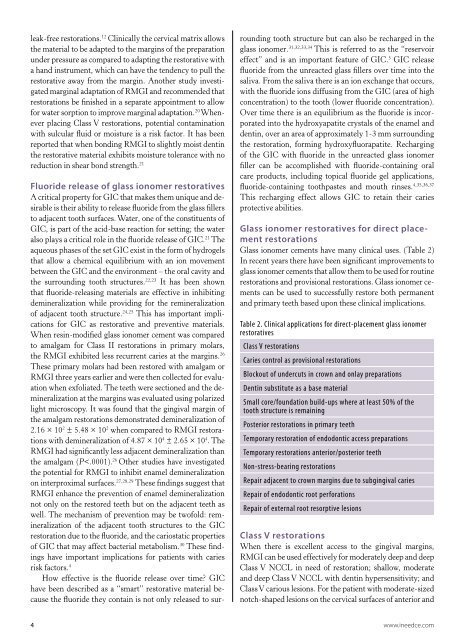Glass Ionomers For Direct-Placement Restorations - IneedCE.com
Glass Ionomers For Direct-Placement Restorations - IneedCE.com
Glass Ionomers For Direct-Placement Restorations - IneedCE.com
You also want an ePaper? Increase the reach of your titles
YUMPU automatically turns print PDFs into web optimized ePapers that Google loves.
leak-free restorations. 12 Clinically the cervical matrix allows<br />
the material to be adapted to the margins of the preparation<br />
under pressure as <strong>com</strong>pared to adapting the restorative with<br />
a hand instrument, which can have the tendency to pull the<br />
restorative away from the margin. Another study investigated<br />
marginal adaptation of RMGI and re<strong>com</strong>mended that<br />
restorations be finished in a separate appointment to allow<br />
for water sorption to improve marginal adaptation. 20 Whenever<br />
placing Class V restorations, potential contamination<br />
with sulcular fluid or moisture is a risk factor. It has been<br />
reported that when bonding RMGI to slightly moist dentin<br />
the restorative material exhibits moisture tolerance with no<br />
reduction in shear bond strength. 21<br />
Fluoride release of glass ionomer restoratives<br />
A critical property for GIC that makes them unique and desirable<br />
is their ability to release fluoride from the glass fillers<br />
to adjacent tooth surfaces. Water, one of the constituents of<br />
GIC, is part of the acid-base reaction for setting; the water<br />
also plays a critical role in the fluoride release of GIC. 21 The<br />
aqueous phases of the set GIC exist in the form of hydrogels<br />
that allow a chemical equilibrium with an ion movement<br />
between the GIC and the environment – the oral cavity and<br />
the surrounding tooth structures. 22,23 It has been shown<br />
that fluoride-releasing materials are effective in inhibiting<br />
demineralization while providing for the remineralization<br />
of adjacent tooth structure. 24,25 This has important implications<br />
for GIC as restorative and preventive materials.<br />
When resin-modified glass ionomer cement was <strong>com</strong>pared<br />
to amalgam for Class II restorations in primary molars,<br />
the RMGI exhibited less recurrent caries at the margins. 26<br />
These primary molars had been restored with amalgam or<br />
RMGI three years earlier and were then collected for evaluation<br />
when exfoliated. The teeth were sectioned and the demineralization<br />
at the margins was evaluated using polarized<br />
light microscopy. It was found that the gingival margin of<br />
the amalgam restorations demonstrated demineralization of<br />
2.16 × 10 2 ± 5.48 × 10 2 when <strong>com</strong>pared to RMGI restorations<br />
with demineralization of 4.87 × 10 4 ± 2.65 × 10 4 . The<br />
RMGI had significantly less adjacent demineralization than<br />
the amalgam (P

















